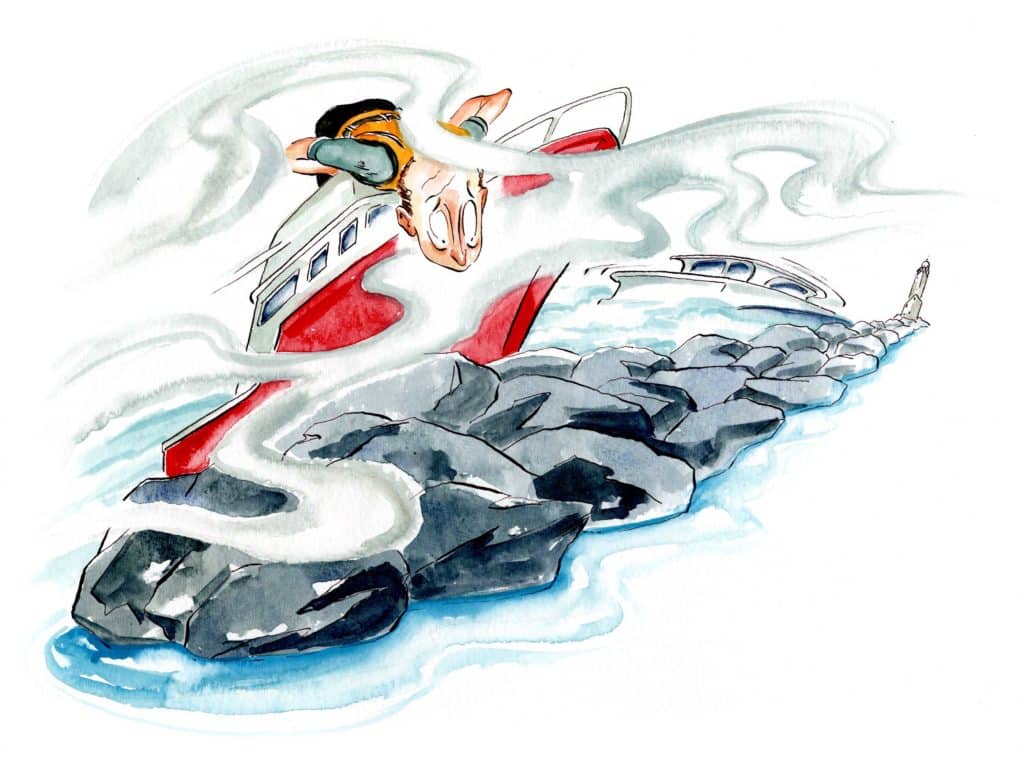
It was a foggy morning at the Frankfort Municipal Marina in Frankfort, Michigan, back in July 2018. We were on a cruise northbound on the big lake (Lake Michigan) in our 1994 Island Gypsy Therapy, a 32-foot trawler.
On the morning of July 23, I backed out of our slip and headed to the channel, which is protected at its entrance by two large breakwaters. A couple of days before, I had guided Therapy past the opening and into the channel—something I had done at least twice a summer for the previous three seasons. I know there is a seawall on the north and south sides. I saw it. I navigated around it. I know it is there.
I was no stranger to fog. This part of the lake encounters it frequently, and it had persisted for 24 hours. I was somewhat familiar with my Garmin’s radar, and my wife and I were ready to leave. We had just seen a larger vessel, at least 60 feet and well-equipped, head out through the channel. I said to myself, If he can do it, I can do it. About 500 yards behind him, I assumed that he would be my guide out into dense but patchy fog. My eyes were fixed on his transom ahead of me, and my radar was up and running.
The best way out of the channel is in the middle. That was my intention, but somehow, with my eyes on the boat ahead, I had difficulty staying in the middle and following the leader. Unaware, I began to drift a little to starboard. Had there been no fog, I would have immediately noticed the need for a course correction and all would have been well. However, I was falsely depending on trailing the lead boat ahead of me while trying to pay attention to the radar and my less-than-visible surroundings.
All of a sudden, I heard the horn blast of the 60-footer, just enough of an attention-getter to cause me to look up and a little to starboard to see what I was about to hit. The north breakwater was about 75 feet in front of us, and we were about to crash. Even at about 4 knots, going cautiously through the fog, that would not have been a pretty picture.
Panic set in, then instincts kicked in—put it in neutral, bring it into reverse, slow her down, give it some more throttle. We came to a stop, probably 25 feet from the huge stone break-water. We had avoided a disaster, barely.
Read Next: Low Visibility Radar Tips
What will I never do again? I won’t head out in conditions that are not safe, at least not safe for me and my boat. I will not assume that the boat ahead of me is following a course that I want to take. I will become much more skilled at using radar.
On a more personal level, I must face the dangers of being overconfident. Fog can always be a challenge. As for patience, we went back to the slip and waited another day before heading north. And when we did, the sun was shining and my heart rate had returned to normal.
George Lambrides
Holland, Michigan (home port)
Wanted: Your Stories
Share your boating mistakes and mishaps so that your fellow boaters might learn from your experience. Send us your first-person accounts, including what went wrong, what you’d do differently, your name and your city, to editor@boatingmag.com and use “ILAB” in the subject line. If your story is selected for publication, we’ll send you a $100 West Marine Gift Card!”









